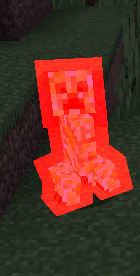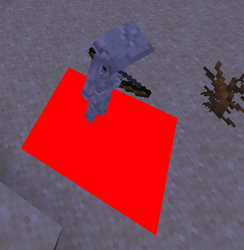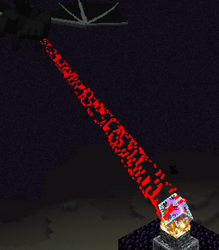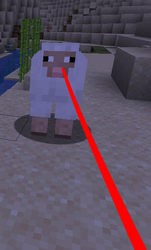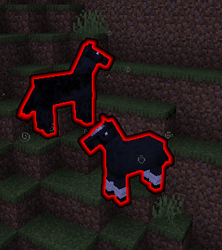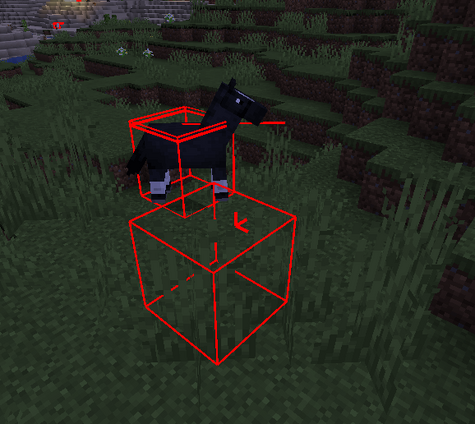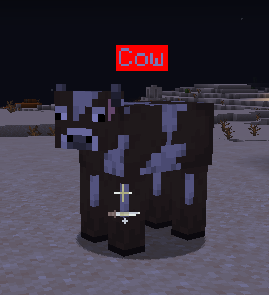Shaders are used to define the game's rendering of certain elements.
Java Edition[]
Two distinct kinds of shaders exist: core shaders and post-processing shaders.
Core shaders are used to render fundamental parts of the game.
Post-processing shaders are used for certain minor visual effects:
- Certain mob vision types as seen in the Spectator gamemode[more information needed]
- The Fabulous! graphics setting's fixed handling of translucent objects
- The glowing status effect
Shaders are written in the OpenGL Shading Language (GLSL). Each single render program comes in two parts, "vertex" and "fragment"; vertex shaders modify the positions of individual vertices, whereas fragment shaders are applied to every pixel. For example, vertex shaders are often used to create waving foliage and water, and fragment shaders can be used to add effects like bloom, god rays, and blur.
Shaders are stored in the assets/minecraft/shaders/ directory of minecraft.jar, and can be replaced with a resource pack. Note that if any error occurs when loading the shaders, the resource pack is disabled and fabulous graphics mode is turned off.
Core shaders[]
Core shaders are responsible for rendering parts of the game. They are used to render not only blocks and entities when playing the game, but also menu and inventory screens.
Each core shader is a single render program defined by a JSON file, in which vertex and fragment shader files are specified.
Core shaders are stored in the assets/minecraft/shaders/core directory of minecraft.jar.
List of core shaders[]
A list of all core shaders can be found by expanding the header below, listing descriptions of what each shader is responsible for, with images highlighting each element in red:
Non-rendertype[]
| Name | Used for | Sample Images |
|---|---|---|
| blit_screen | Blit copies one buffer to another, however this cannot be overridden in a resource pack. | |
| particle | All particles. | |
| position |
|
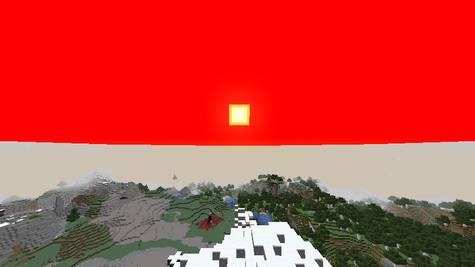
|
| position_color | Used for solid color-block, including:
|
|
| position_color_lightmap | Unknown. | |
| position_color_normal | Unknown; does not seem to be referenced anywhere in code. | |
| position_color_tex |
|
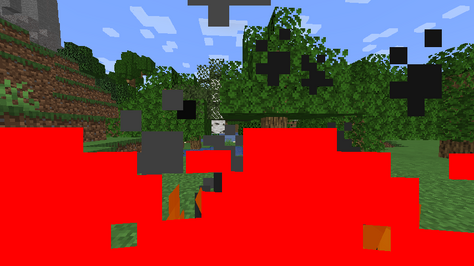
|
| position_color_tex_lightmap | Unknown. | |
| position_tex | Used to render a texture:
|
|
| position_tex_color |
|
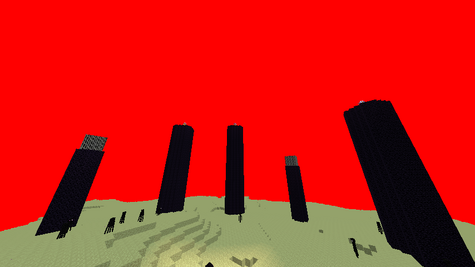
|
| position_tex_color_normal | Clouds. | 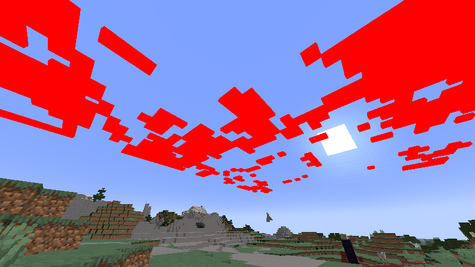
|
| position_tex_lightmap_color | Unknown. |
Rendertype[]
- Blocks
| Name | Description | Sample Image |
|---|---|---|
| rendertype_beacon_beam | The beam of the beacon and end gateway. | |
| rendertype_crumbling | The block cracks when mining a block. | |
| rendertype_cutout | All blocks with partially transparent textures (with the exception of those listed in rendertype_cutout_mipped and rendertype_translucent)
|
|
| rendertype_cutout_mipped | Some blocks: grass blocks, iron bars, glass panes, tripwire hooks, hoppers, chains (leaves when using fancy or fabulous graphics) | |
| rendertype_end_gateway | The inside of an end gateway, reuses the same shader as rendertype_end_portal.
|
|
| rendertype_end_portal | The inside of an end portal, as well as the insides of end gateways. | 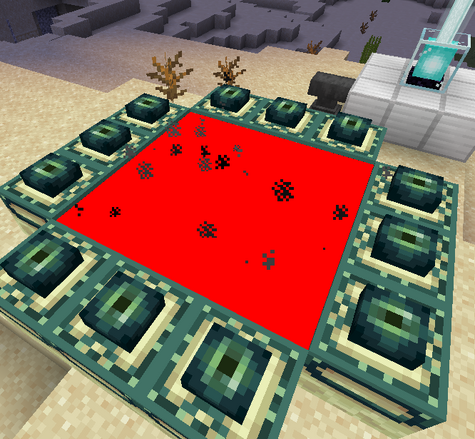
|
| rendertype_solid | All solid blocks, lava, and when in fast mode, leaves. | 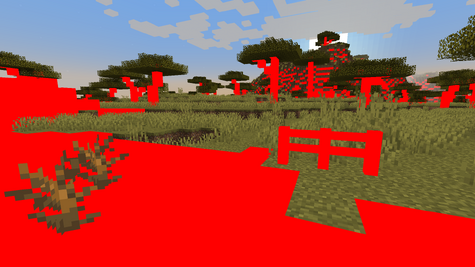
|
| rendertype_translucent | Translucent blocks: water (still and flowing), ice, nether portal, stained and tinted glass, slime and honey, bubbles. | 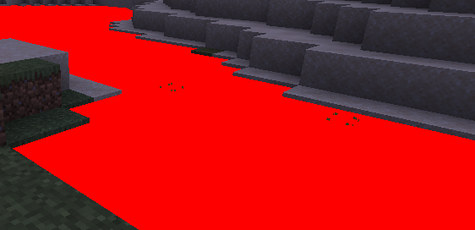
|
| rendertype_translucent_moving_block | Blocks that are translucent and are being moved by a piston. The one below is stained glass. | 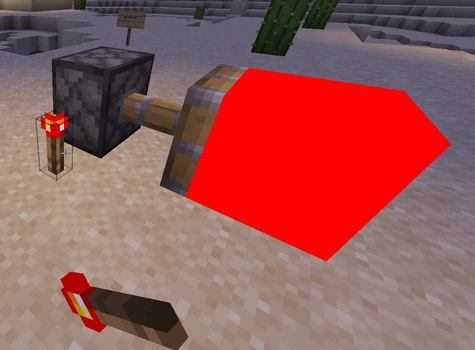
|
| rendertype_translucent_no_crumbling | Unknown. | |
| rendertype_tripwire | Tripwire (sections connected to tripwire hooks are instead rendered completely solid[1] | 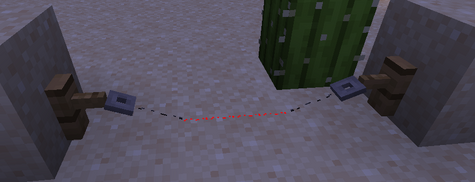
|
| rendertype_water_mask | Used to mask out water surface inside a boat to to prevent it from appearing flooded. |
- Entities
- Miscellaneous
Include shaders[]
Include shaders should be invoked by other shader files; they are not standalone shader programs.
Include shaders contain commonly used helper functions. To import a glsl file in a shader, use #moj_import <FILENAME.glsl> or #moj_import "FILENAME.glsl". The imported file needs to end with an empty line, otherwise the shader does not load.
Include shaders are stored in the assets/minecraft/shaders/include directory of minecraft.jar.
| Name | Description |
|---|---|
| fog | Contains the linear_fog function to calculate the color based on the vertex distance.
|
| light | Contains the minecraft_mix_light function.
|
| matrix | Contains the mat2_rotate_z function that returns the rotation matrix for a vec2 around the z-axis.
|
| projection | Contains the projection_from_position function.
|
Post-processing shaders[]
As mentioned previously, post-processing shaders are used for special Spectator mode mob vision types, the Fabulous! graphics setting, and for rendering the outline associated with Glowing.
Post-processing shaders use "post" files to define a pipeline made up of applying a sequence of "programs". Each "program" is then defined by another JSON file, in which a single render program is defined.
"post" files are stored in the assets/minecraft/shaders/post directory of the jar file, while "program" files are stored in assets/minecraft/shaders/program.
Only five post-processing shaders are currently used in the game:
- creeper.json: Used when spectating a creeper
- invert.json: Used when spectating an enderman
- spider.json: Used when spectating a spider
- entity_outline.json: Used when a glowing entity is on screen
- transparency.json: Used when in "Fabulous!" graphics mode.
In these two directories, there are also many unused shaders, which were used for "Super Secret Settings" before 1.9 (15w31a). See Shaders/Before 1.9.
Render process[]
File format[]
Render program[]
- The root tag
- blend: Settings for OpenGL blending.
- func: Operator to be used when blending. Can be
add,subtract,reversesubtract,reverse_subtract,min, ormax. Not case sensitive. Defaults toadd. Used asmodeparameter ofglBlendEquation - srcrgb: Used as
sfactorparameter ofglBlendFuncorsrcRGBparameter ofglBlendFuncSeparate. Can be0,1,srccolor,1-srccolor,dstcolor,1-dstcolor,srcalpha,1-srcalpha,dstalpha, or1-dstalpha. Case insensitive. Ignores "_". "1", "0", "-" can be replaced by "one", "zero", "minus". - dstrgb: Used as
dfactorparameter ofglBlendFuncordstRGBparameter ofglBlendFuncSeparate. Can be0,1,srccolor,1-srccolor,dstcolor,1-dstcolor,srcalpha,1-srcalpha,dstalpha, or1-dstalpha. Case insensitive. Ignores "_". "1", "0", "-" can be replaced by "one", "zero", "minus". - srcalpha: Used as
srcalphaparameter ofglBlendFuncSeparate. Can be0,1,srccolor,1-srccolor,dstcolor,1-dstcolor,srcalpha,1-srcalpha,dstalpha, or1-dstalpha. Case insensitive. Ignores "_". "1", "0", "-" can be replaced by "one", "zero", "minus". - dstalpha: Used as
dstalphaparameter of glBlendFuncSeparate. Can be0,1,srccolor,1-srccolor,dstcolor,1-dstcolor,srcalpha,1-srcalpha,dstalpha, or1-dstalpha. Case insensitive. Ignores "_". "1", "0", "-" can be replaced by "one", "zero", "minus".
- func: Operator to be used when blending. Can be
- cull: If true, run
glEnable(GL_CULL_FACE). If false, runglDisable(GL_CULL_FACE). Defaults to true. - vertex: The name (without file extension) of the vertex shader to be used.
- fragment: The name (without file extension) of the fragment shader to be used.
- attributes: Attributes to be used by the vertex shader.
- : An attribute. Available values are hard-coded.
- samplers: A list of samplers that may be used in the shaders.
- : A sampler.
- name: The samplers name.
- : A sampler.
- uniforms: A list of uniforms that can be used in the shaders.
- : A uniform.
- name: The name of the uniform as referenced in the GLSL code. Some names give a uniform special behavior(Note that these following special uniform does not work in all shader programs):
- (float) Time: A value from 0 to 1, representing time in seconds. Resets every second. Valid only in post-processing shaders.
- (vec2) InSize: The width and height of the input buffer in pixels. Valid only in post-processing shaders.
- (vec2) OutSize: The width and height of the output buffer in pixels. Valid only in post-processing shaders.
- (vec2) AuxSize<i>: The width and height of the auxiliary buffer in pixels. <i> should be replaced by the order of the auxtarget in the render pass. Valid only in post-processing shaders.
- (matrix4x4) ModelViewMat: The model-view matrix. Valid only in core shaders.
- (matrix4x4) ProjMat: The projection matrix.
- (matrix4x4) TextureMat: 4D matrix used to transform UV's for item glint effects. Valid only in core shaders.
- (vec2) ScreenSize: vec2 containing the current framebuffer width and height, in that order.
- (vec4) ColorModulator: A global vec4 of multipliers that can be set from the game code as a color multiplier. Valid only in core shaders.
- (vec3) Light0_Direction: First light direction as vec3 for entity rendering. Valid only in core shaders.
- (vec3) Light1_Direction: Second light direction, see Light0_Direction. Valid only in core shaders.
- (float) FogStart: Fog start distance from the camera. Valid only in core shaders.
- (float) FogEnd: Fog end distance from the camera. Valid only in core shaders.
- (vec4) FogColor: vec4 fog color. Valid only in core shaders.
- (float) LineWidth: Line width, used for rendering wireframe lines such as the block selection frame and debug hitboxes. Valid only in core shaders.
- (float) GameTime: Global time of the world, in fractional days. Valid only in core shaders.
- (vec3) ChunkOffset: When rendering a chunk section, the offset from the camera world position to the chunk section's base point. Valid only in core shaders.
- type: The type of the uniform. Can be one of
int,float,matrix4x4,matrix3x3andmatrix2x2.intcan also be interpreted asivec2,ivec3orivec4depending on how many values are actually included invalues.floatcan also be interpreted asvec2,vec3orvec4depending on how many values are actually included invalues. - count: The number of values included in
values. - values: The value of the uniform, given as a list of floats. The length of the list should be the same as
count.
- name: The name of the uniform as referenced in the GLSL code. Some names give a uniform special behavior(Note that these following special uniform does not work in all shader programs):
- : A uniform.
- blend: Settings for OpenGL blending.
Render pipeline[]
Here's the process of how a post-processing shader is used in game: first, the shader initializes all of the render targets specified in the "targets" list with the proper width and height. After that, the shader goes through each render pass specified in the "passes" list from first in the list to last in the list. Each pass applies the program shader on the render target specified by "intarget" (with any extra data provided by other auxiliary render targets) and output the end result on the render target specified by "outtarget".
- The root tag
- targets: A list of render targets. They can be buffer provided by the game, or new buffer with any name.
- : The name of a render target. The size defaults to screen resolution. Post-processing shader
transparencymust contain render targets namedtranslucent,itemEntity,particles,weatherandclouds. Post-processing shaderentity_outlinemust contain a render target namedfinal. - : A render target to add.
- name: The name of the render target to add.
- width: The width of the render target.
- height: The height of the render target.
- : The name of a render target. The size defaults to screen resolution. Post-processing shader
- passes: A list of passes.
- : A render pass.
- name: The name of a program shader to apply on the input and post into the output. Use "blit" to copy the data from intarget to outtarget.
- intarget: The name of a render target to use as an input. Use
minecraft:mainto specify the main screen. - outtarget: The name of a render target to output to. It should not be the same as intarget. Use
minecraft:mainto specify the main screen. - auxtargets: A list of auxiliary targets.
- An auxiliary target.
- name: The auxiliary target's name that is passed into the "Program" JSON.
- id: The auxiliary target's id. Either points into the name of a buffer that is defined in
targetsor into the location of a texture underassets/<namespace>/textures/effect(use a resource location to reference it). Append:depthafter the name of the buffer to access its depth buffer. For example, to access the depth buffer ofminecraft:main, useminecraft:main:depth. - width: Required if
idreferences a texture. Describes the width of the texture in pixels. - height: Required if
idreferences a texture. Describes the height of the texture in pixels. - bilinear: Required if
idreferences a texture. Determines whether the scaling algorithm used for the image is bilinear or nearest neighbor.
- An auxiliary target.
- uniforms: A list of overrides that change the values in the
uniformslist in the "Program" JSON.- : A uniform.
- name: The name of the field that should be changed.
- values: The values that the field should be changed to.
- : A uniform.
- : A render pass.
- targets: A list of render targets. They can be buffer provided by the game, or new buffer with any name.
Tutorials and useful docs[]
Here are some guides with additional information on creating shaders:
Bedrock Edition[]
Since Bedrock Edition 1.18.30, third party shader resource packs are no longer supported on all devices except Fire OS.
History[]
| Java Edition | |||||
|---|---|---|---|---|---|
| 1.7.2 | 13w38a | Shaders were added for Super Secret Settings. | |||
| 1.8 | 14w05a | The Creeper and Spider shaders were added. Shaders are automatically applied in spectator mode when viewing the world as a Creeper, Spider or Enderman. | |||
| 14w05b | Shaders have been removed from view when changing perspective while spectating a mob.[2] | ||||
| F4 toggles different shaders rather than turning them off.[2] | |||||
| 14w06a | The Entity Outline shader was added. | ||||
| 1.9 | 15w31a | Removed the Super Secret Settings button for an internal rewrite.[3] | |||
| 1.16 | 20w22a | The Transparency shader was added for Fabulous! graphics mode. | |||
| 1.17 | 21w10a | Core shaders were added. | |||
Gallery[]
Issues[]
Issues relating to "Shaders" are maintained on the bug tracker. Report issues there.
References[]
- ↑ MC-214692
- ↑ a b MC-46727 (comment#219617)
- ↑ "nah just rewriting it all :p They are still in the game, the button is just gone atm. It would make more sense to keybind imho" – @_grum (Erik Broes) on X, July 31, 2015

